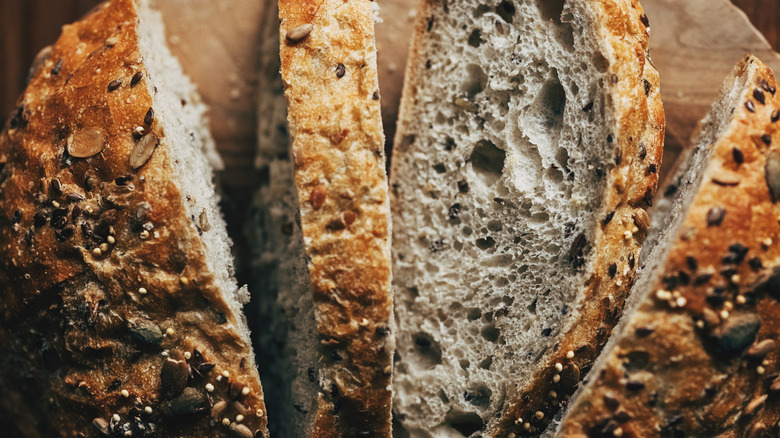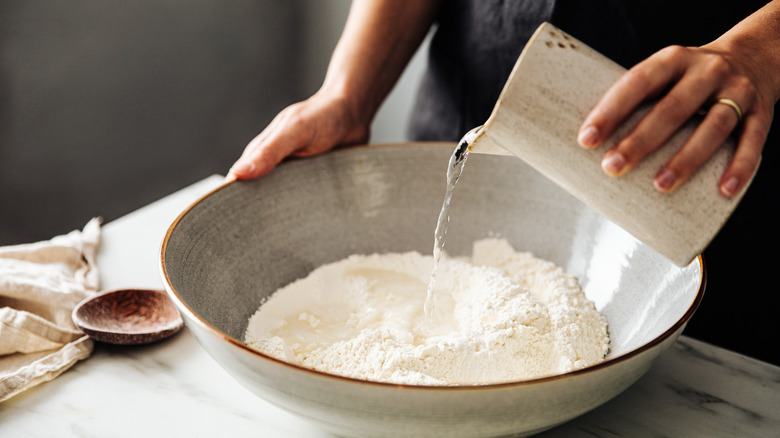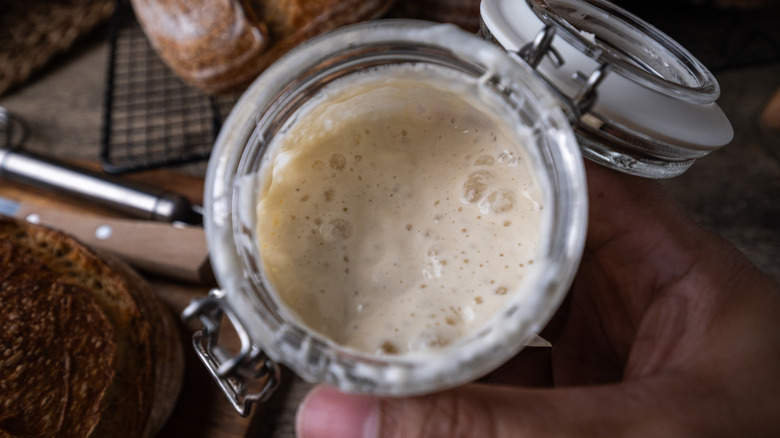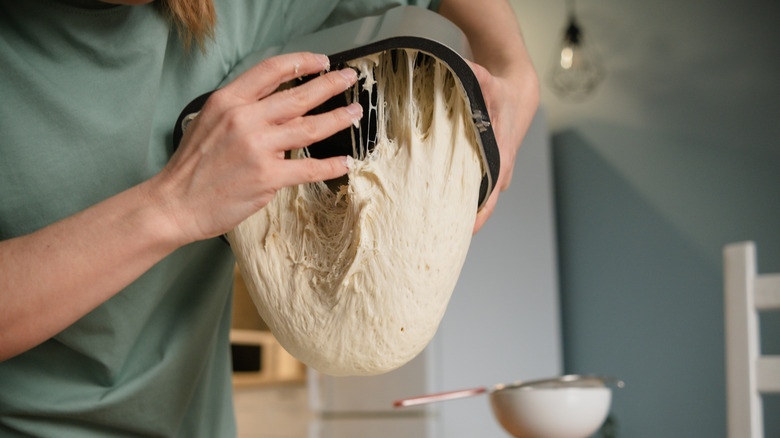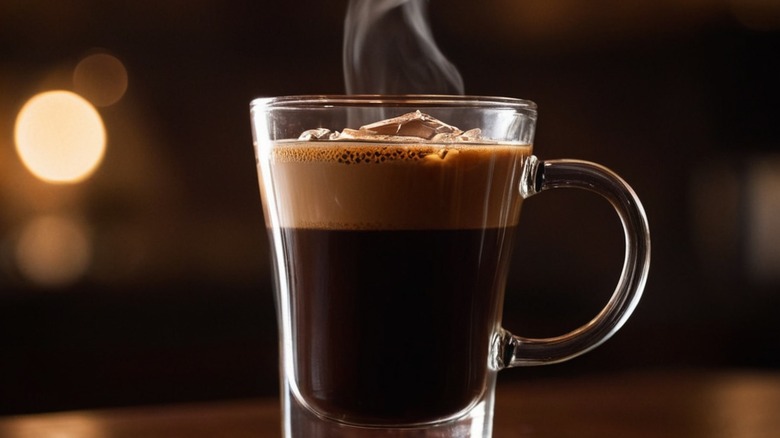What Is Dough Hydration And Why Does It Matter In Baking?
If you're like this writer, chances are good you've considered becoming A Real Sourdough Baker. Come spring 2020, recipes for sourdough cropped up all over social media, and anyone with half a domestic bone in their body suddenly dreamed of opening a cottage bakery. Turns out, as anyone who has actually tried their hand at making bread knows, there's a tad more to it than cute TikTok videos. One of the most science-y and important aspects? Hydration, or the water-to-flour ratio of a particular dough.
"Hydration is essential in bread baking to achieve elasticity and malleability, and [it] even aids with leavening," explains Trina DeKett, a former pastry chef and current operations and creative specialist at BaKIT Box. "Further, hydration directly affects how quickly our dough ferments, the volume of both the dough and final product, and even the final structure of the crumb." When creating different kinds of breads, she adds, it's essential to be aware of your hydration, as its properties fundamentally alter the result.
Hydration is a basic concept, but it's tricky to get right, especially as there are different hydration requirements at different stages of making dough (e.g. with starter, sponge, poolish, and the dough itself). For some baked goods, it doesn't matter as much, but for higher-precision ones such as sourdough bread or pizza crust, where you're looking for specific qualities, it really does matter. Chowhound asked the experts everything there is to know.
What is hydration in bread science?
Hey, remember the whole "we asked the experts everything there is to know" thing? Well, that's silly. There's ever so much to understand about bread, and people can spend whole lifetimes learning. Hydration is the same. The wrong hydration is the reason store-bought dough fares so poorly on the grill when making pizza, for instance. It even matters when making pasta dough ... or resting pasta dough. It is, in other words, an extremely useful concept.
In essence, says Jessie Johnson, founder and bread teacher at Life As A Strawberry, "Hydration is a term for the total amount of water in a loaf of bread, expressed as a percentage of the total amount of flour." The exact formula, according to The Sourdough Baker founder Caitlin Vincent, is (weight of water/weight of flour) × 100. For example, Johnson says, if a loaf of bread uses 75 grams of water and 100 grams of flour, you would calculate hydration as (75/100) × 100 = 75, which you express as a percentage, in this case, 75%.
"Essentially, it's shorthand that helps you quickly understand what a batch of bread dough should look and feel like," Johnson explains. Higher hydration means wetter and stickier doughs, while lower hydrations equal drier ones.
Which baked goods benefit from hydration?
Hydration "comes up with just about every kind of yeasted bread, from crusty sourdough to soft sandwich loaves and pizza dough," says Marissa Stevens, founder of Pinch and Swirl. "Getting that ratio right can completely change how the dough behaves and how the finished bread feels and tastes."
While wet-to-dry ratios matter to pretty much every kind of baked good, "hydration percentages are used most often when we're talking about fairly straightforward loaves of bread, like no-knead Dutch oven bread, a traditional boule (round) shape, or a loaf of sourdough," Jessie Johnson says. You can actually calculate the hydration of any recipe that mixes dry goods and liquids. "Even your favorite cupcake recipe, pancake batter, or pasta dough can be described in terms of hydration!" she says. When you get to more complicated recipes such as birthday cake, though, the math is no longer useful.
Hydration really is a water-forward concept. "The term is mainly used to understand bread doughs (yeasted or sourdough) that are mostly unenriched," Caitlin Vincent says, "That means they might contain small amounts of fat or sugar, but not enough to define the bread." In the case of these breads, the relevant liquid is water rather than oils, eggs, or milk. In more complex recipes, thus, it doesn't really make sense to talk about hydration.
Why does hydration change at different stages?
A common question vis-à-vis bread baking is why hydration changes at different stages, but this is a misconception. "Hydration does not change at different stages of making bread," Caitlin Vincent says. "Unless you add water, the hydration stays the same. Now, the dough may feel different, and that's because flour absorbs water over time." Similarly, Jessie Johnson says, "People often mistake hydration for gluten development. When their dough feels sticky, new bakers often default to adding more flour to the dough (thus reducing the hydration percentage), when what the dough actually needs is more strength, which is achieved by kneading, folding, and adequate rising time."
That's what makes it so important to understand hydration itself, namely the concept that the recipe calls for so much flour and so much water for a reason. Add more flour (or more water), and you will disrupt the dough's ability to form the desirable characteristics of that recipe: pillowy cinnamon rolls, chewy pizza dough, or a sourdough boule with large interior air bubbles.
In some cases, using a different method can also affect hydration. "In methods like tangzhong — where you cook a small portion of the flour with liquid into a paste — you're pre-hydrating some of the flour, which lets you use more liquid overall without the dough turning into a sticky mess," Marissa Stevens says. "The type of flour you're using, humidity, and even the brand can also affect how much water it'll take on."
How hydration changes flavor
It may not surprise you at this point to learn that hydration levels affect the final taste of your bread product. "Doughs that utilize higher hydration like baguettes, ciabatta, and even focaccia tend to be more flavorful," Trina DeKett says. "This is because there is more time for them to develop a complex flavor profile due to a longer fermentation period. You're likely to taste notes of nuttiness, sourness, and sweetness, which blend perfectly in your final product."
Other notes that may come to the front include tanginess and yogurt-like flavors, Caitlin Vincent says, both of which are due to greater lactic acid levels in higher-hydration doughs. "On the flip side, a stiffer (lower hydration) dough tends to produce a more neutral flavor in most cases," she says, though she's careful to clarify that flavor depends on a number of factors, including the state of your starter, your fermentation temperature, the flour type, and your overall process.
Hydration's impact on consistency and workability of dough
Hydration changes texture quite a bit, which has major impacts on consistency and workability. For instance, many people make mistakes when baking homemade bagels and can't figure out why they come out crummy (or less crumb-y, if you will), but it's often due to hydration.
In general, lower-hydration doughs are easier to manage, Jessie Johnson says, because they're stiffer and less sticky. This makes them easier to knead and shape, at least when you're new to baking. Again, though, wetter doughs often need more working rather than more flour because hydration levels change how you develop the gluten and structure of your dough. "A low hydration dough needs to be kneaded early on, since the lack of moisture can make it harder for gluten to form," Caitlin Vincent says. "Surprisingly, the same is true for very high hydration doughs, as too much moisture can actually prevent gluten from developing properly. These wetter doughs also require more folds during fermentation to build structure and help the dough hold its shape and rise well in the oven."
Circling back to the bagels, Trina DeKett explains that "bagels have a low hydration point, therefore the kneading and shaping process is much more strenuous than focaccia, which requires less kneading and more folding." It is a mistake to add water to your bagel dough, though, because that will change its chewy texture. Instead, you must add elbow grease (everybody's favorite).
Aeration as a result of hydration
Getting your bread to rise is a trial as old as time. Sometimes you get great aeration and a beautiful lift; sometimes it's Pancake Town, and if you're a novice (*raises hand*), it's often hard to tell why. There are many ways to hack a faster bread rise, of course, some of them more expensive than others, but it often comes down to what happened at square one when you were first mixing flour with water.
"The only real link between hydration and aeration is through gluten," Caitlin Vincent says. "Dough becomes aerated through mixing, folding, and fermentation, but all of that relies on the presence of strong gluten. And for gluten to form properly, the flour has to be hydrated just right." If you use too much or too little flour, she explains, the dough won't hold together well, which will affect its ability to trap air and rise the way it should.
If your overarching goal is big, beautiful air bubbles, though, you should aim for a higher-hydration dough. "Higher hydration bread can produce a chewier crumb with big, beautiful air pockets, which many bakers aspire to. Higher hydration dough requires some practice (and patience)," Jessie Johnson explains.
Doing the math: Low, medium, and high hydration levels
Remember that the proper way to calculate hydration is (weight of water/weight of flour) × 100, with the final number expressed as a percentage. Although experts may disagree a bit about the numbers, high-hydration doughs are usually around 80%-100% (or sometimes more), while low-hydration doughs are around 60% or lower. Anything in between could be considered medium.
So, where to begin? "It's helpful to start with lower hydration doughs," Caitlin Vincent says. These require less management because the dough isn't as floppy. "Once you feel more confident, you can begin increasing the hydration gradually, about 5% at a time. This gives you a chance to learn how the dough behaves at different hydration levels and helps you understand how much water your specific flour can handle." That last point is critical since each type of flour absorbs water differently. In her bread course for beginners, Jessie Johnson starts with a beginner's loaf that is 70% hydration.
"The more hydrated the dough is, the more open and irregular the crumb tends to be," Marissa Stevens says. "It also allows for more fermentation and enzyme activity, which can mean better flavor." She is quick to acknowledge that flavor is subjective. "The tradeoff is that wetter doughs are harder to work with. That's where tangzhong helps," she says. By pre-cooking some flour into a paste, "it lets you push hydration higher without making the dough frustrating to shape."
Hydration in starter
Undoubtedly one of the most common sourdough starter mistakes, and bread errors in general, is not understanding hydration. If you want to make a sourdough starter, you first need to understand the ratio of flour to water needed. That's because, while hydration is an important concept as a whole, it matters to individual bread stages and techniques as well.
"Hydration in sourdough starter is so important," Caitlin Vincent says. "It's closely tied to acid production, which means different hydrations lead to different kinds of acids, which directly impacts both flavor and performance." Lactic acid bacteria (LAB) thrive in warm, wet environments, while lower-hydration starters limit those same bacteria. Unfortunately, LAB are responsible for a lot of the desirable tanginess in bread, so you want to give them room to do their thing.
There's another reason to ensure your starter is wet enough: protease activity. "Protease is the enzyme that breaks down proteins in flour," Vincent says. "This process is essential; without it, your bread wouldn't ferment and rise properly." You want to strike a balance, which typically ends up being around 100%, according to Jessie Johnson, though this is flexible. "In the summer, I sometimes lower the hydration of my starter to 80%-90%, which gives it more resilience in especially hot weather."
Hydration in a sponge
First of all, what the heck is a sponge? "A sponge pre-ferment contains flour, water, and yeast," Trina DeKett explains. "We typically use a sponge pre-ferment for enriched doughs, like brioche. I recommend using a lower hydration for this, 55%-60%." This translates to roughly a 2:1 ratio of flour to water, she says, but not exactly, so do your measurements. The goal is to promote a bit less elasticity, she says, which comes from the butter in the recipe rather than the higher hydration. "Having our pre-ferment have a lower hydration is helpful for richer doughs, as it provides the extra strength needed, due to rich doughs not promoting as much gluten development," she says.
Do note that the hydration does change quite a bit depending on the recipe. Marissa Stevens estimates many sponges to be around 60%-70% hydration, while Jessie Johnson has "seen suggestions range from 60% to over 100%."
Hydration in poolish
Poolish is best described as a liquid dough that sits for hours to ferment before being added to the final dough. "A poolish is best used for breads that require extensive shaping, such as baguettes," Trina DeKett says. "This is my personal favorite pre-ferment as this allows our dough to be incredibly elastic. Because of how liquid-based it is, as well as how little salt is needed, this pre-ferment allows the gluten to relax, which is how we end up with such an elastic final dough."
Poolish should always be 100% hydrated, DeKett says, and the experts agree. Jessie Johnson and Marissa Stevens both advise using hydration levels of 100% for poolish. Its runniness doesn't matter since it is later incorporated into a larger body of dough. If you're trying to imagine the consistency here, think thick batter, Stevens says, rather than actual dough.
Hydration in dough
Because higher-hydration doughs tend to be more elastic, more aerated, and faster fermenting, they have more of that tangy flavor due to happy, abundant lactic acid bacteria. "The key thing to understand is that your bread dough inherits the characteristics of your starter," Caitlin Vincent says. "It's essentially a larger version of it." Thus, if you have specific characteristics you want in your final bread product, circle back to your starter and begin there.
That's not to say you don't have to pay attention to hydration in your dough, though; you most certainly do. "Most bread doughs still require some hydration even with utilizing a pre-ferment," Trina DeKett explains. "Depending on your desired final end product, you can add in hydration according to your preference." For doughs that use a poolish or starter, you'll probably need to add less. No matter what, you will need to account for the flour-to-water ratio in your pre-ferments as well as the final dough.
How to begin experimenting with hydration
Ready to experiment? "My biggest suggestion is to find a bread recipe with a pre-ferment that works well for you first," Trina DeKett says. "Make it at least 5-10 times, noting any discrepancies based on temperature and humidity fluctuations, oven hot spots, and general folding/kneading patterns. Once you have a good baseline, it's far easier to manipulate the recipe based on preference."
When you do start changing humidity levels, shift them up or down no more than 5% at a time. To adjust hydration, Caitlin Vincent says, multiply the total amount of flour by the decimal version of your desired hydration percentage. For example, if your recipe has 500 grams of flour and you want 75% hydration, she says, multiply 500 × 0.75 to get 375 grams of water.
Adjusting recipes when necessary
Recipes can vary depending on factors outside the flour-to-water ratio. For instance, Caitlin Vincent says, the type of flour can play a huge role in the look and feel of the dough, even if the hydration level is the same for, say, rye and wheat flour. "70% hydration is still 70%, no matter how the dough behaves," she says.
Also, keep in mind that climate and elevation affect recipes quite a bit. Drier climates may cause your dough or starter to lose moisture faster than humid ones, while high elevations need more water than lower ones. Adding tangzhong is a good way to make things softer, but it's not everything. "It's perfect for soft loaves that you want to stay tender for a few days," Marissa Stevens adds. "For rustic breads where you want more chew and structure, it's not the right fit."
Jessie Johnson says, "I always tell our students that great bread is 10% recipe and 90% technique. With hydration, as with any aspect of bread baking, the most important ingredient is practice."
Using liquids other than water
There are tons of ways to upgrade your basic white bread (or any kind of bread), from using mix-ins to leaning on liquids other than water. As for the latter technique, there are lots of options. "I use milk all the time in soft breads, and it's key in tangzhong recipes," Marissa Stevens says. She has also used buttermilk, beer, and even orange juice in certain doughs, making sure to adjust the recipe to account for how those liquids behave. "Milk makes the dough richer and more tender, while acidic liquids like buttermilk affect gluten development," she says.
Any liquids can technically be counted toward hydration, Caitlin Vincent says. Coffee, tea, pizza sauce, jam, and wine are others that add a lot of flavor, though even basic ingredients such as eggs and butter can count, since they contain significant water levels. This will make your math more complicated, though. For instance, eggs are 75% water, so you'll need to multiply the total amount of eggs by .75 to understand their hydration impact.
Bottom line? "While baking is indeed a science, it is also a creative outlet," Trina DeKett says. "Baking is a playground. ... Even if it doesn't turn out the way you want it, take notes, take pictures, and learn."
